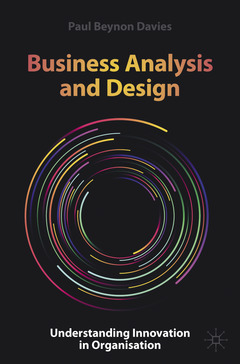Description
Business Analysis and Design, 1st ed. 2021
Understanding Innovation in Organisation
Language: English
Subject for Business Analysis and Design:
409 p. · 15.5x23.5 cm · Paperback
Description
/li>Contents
/li>Biography
/li>Comment
/li>
This textbook offers an essential introduction to design orientation in business, which impacts the way management is undertaken world-wide. Design orientation, as it applies to business, is the process through which a designer analyses business as a system, identifies motivation for changing the system, and designs improvement for the organisation, as well as ways of implementing this improvement. It involves strategic and innovative thinking, communication with key stakeholders, and change management.
This book provides coverage of critical tools for design which enable business professionals to analyse existing ways of organizing and to design new ways of organizing. The reader will learn how to develop a digital business model to organize private, public or voluntary work. In doing so, the reader will learn to critically evaluate the notion of digital innovation and understand the proper place of ICT within organization.
The reader will learn how to:
- critically evaluate the relevance of digital innovation to domains of organisation
- develop digital business models to organize private, public or voluntary work
- construct business strategy and relate it to business models, motivation models, innovation management and change management
Written by an expert in the field, this book is designed for both students and professionals. Each chapter contains an introduction, a section of key reading, and a summary, while a number of cases based on real-life examples are worked through as examples in the text, demonstrating the real-life application of the design theory discussed.
Chapter 1: Signs, patterns and systems.- Chapter 2: What is Design?.- Chapter 3: Designing Organization.- Chapter 4: Projects of Design.- Chapter 5: Investigating domains of organization.- Chapter 6: Engaging with problem situations.- Chapter 7: Making sense of business activity.- Chapter 8: Models of activity.- Chapter 9: Making sense of business information.- Chapter 10: Making sense of information systems.- Chapter 11: Models of information.- Chapter 12: Making sense of business data.- Chapter 13: Making sense of data systems.- Chapter 14: Models of Data.- Chapter 15: Understanding digital innovation.- Chapter 16: Building digital business models.- Chapter 17: Business motivation, strategy and evaluation.- Chapter 18: Epilogue.
Paul Beynon-Davies is Professor Emeritus at the Cardiff Business School. Before taking up an academic post, Professor Beynon-Davies worked for several years in the informatics industry in the UK both in the public and private sectors. He has published 13 books and over eighty peer-reviewed academic papers, many in leading journals such as the Information Systems Journal, the European Journal of Information Systems and the Journal of the Association for Information Systems.




